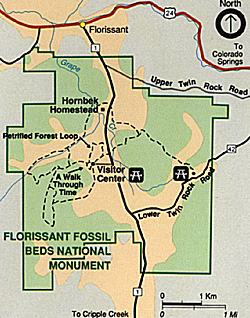 Adeline Hornbek is an outstanding example of early Colorado settlers and
was the first to homestead on the land that is now within Florissant Fossil Beds
National Monument. She was very successful in dealing with the rigors of pioneer
life. Physically she was impressive as well. At about 5'7" she was quite tall for a
woman in the 1800's and had striking red hair. In her lifetime she had three
husbands, four children and lived among two different Indian tribes.
Adeline Hornbek is an outstanding example of early Colorado settlers and
was the first to homestead on the land that is now within Florissant Fossil Beds
National Monument. She was very successful in dealing with the rigors of pioneer
life. Physically she was impressive as well. At about 5'7" she was quite tall for a
woman in the 1800's and had striking red hair. In her lifetime she had three
husbands, four children and lived among two different Indian tribes.
Born Adeline Warfield in Massachusetts, July 1833, she first married at the age of 25. Her husband Simon A. Harker was an Indian trader/merchant in business with Adeline's brother Alexander in the Creek territory (present day Oklahoma). Simon, then 33, had immigrated from England twenty years earlier A son, Frank, was born the next year on Nov. 3, 1859 and 10 months later daughter Annie arrived.
Simon wrote that in July, 1860, "I exposed myself too much when buying cattle and am afraid I have injured my constitution." This long lasting illness may be one reason that the young family left the Creek Agency and traveled to the arid West by wagon in the summer of 1861. Perhaps their trip was motivated by concern over the Civil War. The Harkers settled beside the South Platte River just northeast of the new Denver City. Here they farmed and raised cattle.
In September of 1863 Adeline's second son, George, was born. At the nearby Golden City land office Simon filed a claim on the 160 acres under President Lincoln's Homestead Act of 1862.
The next year was one of tragedy for the Harkers. During the famous flood of 1864 they suffered extensive losses and Simon, 39, died soon after. Adeline was left with three small children ages one, four and five.
It appears that she managed very well and bought 80 acres of their claim outright in July of 1866 for $100 cash, two years before the final proof was due. Adeline Harker took advantage of a clause in the homestead legislation that allowed the homesteader to purchase the land after six months residence for $1.25/acre.
Two months later she married Elliot Hornbek in Denver.*
There is an air of mystery surrounding Mr. Hornbek and he disappeared from the scene in 1875 after fathering Elliot Jr., born about 1870. His occupation and why he abandoned his family is unknown, perhaps Adeline left him. One report places Mrs. Hornbeck and her four children in the Colorado Springs region as early as 1872. Whichever the case, separation was rare in this era.
THE FLORISSANT YEARS
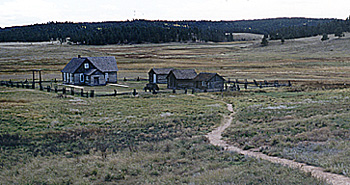 By early spring of 1878 Adeline Hornbek, at 44, as sole supporter of her
family, had built a fine ranch in the Florissant valley. From the details of her
homestead application she appears unique in four respects. First, she was a
woman with four children (Frank 18, Annie 17, George 14 and Elliot 7). Secondly,
she was the first person to file on land that would become part of Florissant Fossil
Beds National Monument. She was financially well off, presumably due to land
transactions around Denver. And lastly, the home she had built was uncommonly
large.
By early spring of 1878 Adeline Hornbek, at 44, as sole supporter of her
family, had built a fine ranch in the Florissant valley. From the details of her
homestead application she appears unique in four respects. First, she was a
woman with four children (Frank 18, Annie 17, George 14 and Elliot 7). Secondly,
she was the first person to file on land that would become part of Florissant Fossil
Beds National Monument. She was financially well off, presumably due to land
transactions around Denver. And lastly, the home she had built was uncommonly
large.
In selecting her homestead site there was much to consider. From her years with the Creek Indians, the Utes of Florissant probably caused her no alarm. The Castello trading post two miles north offered neighbors and supplies. Abundant grass, fertile bottom-land soil, nearby timber and water completed the ideal setting.
When describing her house and the improvements that first year, Mrs. Hornbek stated that there was "a Log House 1 and 1/2 story, 3 rooms upstairs - 3 rooms downstairs ... shingle roof, eleven windows ... A good Milk House. Chicken House. A large corral - has sheds on two sides. Stables for 9 horses, Has wagon shed attached. Whole interest in 1/4 mile Ditch and one half interest 1/2 mile Ditch." Her root cellar was in the nearby hill. She placed the value of the ranch in 1878 at $1200. Of her 160 acres Adeline began by cultivating 3 acres, raising potatoes and garden vegetables, and cutting 20 tons of hay Quite an impressive start!
Adeline had interest outside the ranch which son Frank helped manage. In 1880 she served as secretary on the Florissant School Board and in 1883 she worked in a general store in Florissant.
As further evidence of this pioneer woman's skill and ambition, by 1885 (the year she filed her final homestead papers) Adeline Hornbek had increased the value of her property by almost five times. Her livestock included "21 horses, 4 milk cows, 100 other cows (probably Texas longhorn/Hereford cross) 3 swine and 50 poultry." Her son-in-law Leon Marcott wrote of her intentions in acquiring land under the Homestead Act, "No one could have acted in better faith."
Local tradition tells that the prosperous Mrs. Hornbek traveled frequently in the United States and Europe. At age 66, Adeline was married to Frederick Sticksel, a German immigrant who is said to have worked for her.
On June 27, 1905, Adeline Warfield Harker Hornbek Sticksel, age 71, died of "paralysis", which today might be called a stroke. She left a legacy for future generations to marvel at and had lived 27 years on her mountain valley ranch.
WOMEN AND THE HOMESTEAD ACT
In an effort to popu late the West and ease the crowding in the East, President Abraham Lincoln offered free public land to settlers with the passage of the Homestead Act of May 20, 1862. The homesteader was required to be a loyal U.S. citizen (or declare intent to become a citizen), head of a family and over twenty-one years of age. Continuous residence on and improvement of the land was necessary for five years, at which time the final proof could be made. The registration fee was usually $14. Any man or woman who met these requirements could gain title to 160 acres of land.
Now, for the first time in American history, working-class women had access to land ownership, because the land was free. Since land ownership is linked to economic power in American society, homesteading women emerged as a hidden force on the agricultural frontier.
ABOUT THE HORNBEK HOMESTEAD BUILDINGS
The main house is the only remaining original structure from Adeline
Hornbek's Homestead. Succeeding landowners tore down or replaced the
outbuildings. Historic buildings located elsewhere on the Monument were moved in
to represent the lost bunkhouse, carriage shed and barn. Her root cellar had caved
in by the time the United States government bought the property in 1973. When
the National Park Service began restoration of the Homestead in 1976, the root
cellar was rebuilt following the 1878 design and dimensions. Some of the
authentic timbers can be seen in the walls.
Large Photo of Hornbek House (slow: 103K)
During the Bicentennial restoration of the Homestead. the main house was furnished with period antiques. Unfortunately, this furniture was stolen. It remains empty.
The kitchen was the center of activity and would have been furnished with a
large table, cookstove and wash basins. The pantry stored canned goods, staples
such as sugar and flour, and cooking utensils.
The Hornbek's neighbors came to Saturday night dances in the parlor. These
evenings were made even more special by Adeline's organ. The back room,
probably shared by Annie and Adeline, was quite a luxury considering that most
homesteads of this day would only have been the size of this one room. There is
no evidence of an original hand rail for the steep stairway leading up to the boys'
rooms. Going up and down in a long dress must have been challenging!
During Adeline's day, water was hauled from Grape Creek to the south. A wel
I house was added by the Laffertys in 1909. The Laffertys were close friends of
Adeline's and bought the ranch from Frank after she died. Once the well was dug, a
three-sided well house was placed up against the main house. Posts were placed
on the outside of the two walls beside the home and connected to each other with a
cable. The cable was tightened with a turnbuckle arrangement which prevented the
well house from sagging away from the house. It is interesting to note how rough
and different the well house log construction is compared to the main house.
Floor Plan of Hornbek House (slow: 80K)
The bunkhouse building you see today was built by German sheep rancher
Herman Halthusen. in 1880. Halthusen was a controversial figure in the Florissant
valley and sparked a range war over his sheep. Eventually Halthusen won out and
continued raising sheep. Since Adeline Hornbek had a registered sheep brand as
well as a cattle brand it is likely that she saw profit in both types of livestock.
Adeline kept four milk cows and her barn stood near this site. Her larger
horse barn was on the hillside to the north. This small building was constructed in
1890 by Del Johnson. Before becoming a rancher, Johnson was one of the last
true cowboys, participating in cattle drives north from Texas on the Chisholm Trail.
Johnson did all the work on the structure by himself, with the attention to detail
showing in the neat corners.
This was home to Del and his wife for many years and is typical of
homestead houses of this time. It would easily fit in the downstairs bedroom of
the Hornbek home. When the Johnsons built a frame house they converted this
building into a barn, with stanchions for milking cows, hay trough and a small hay
loft for storing a few days worth of hay in case of bad weather.
In 1880, 21 year old Frank Harker was working as a "laborer" in Rico, Colo.
After prospecting in the San Juan mountains, he homesteaded in Meeker on the
Western Slope with a wife and four children. By 1905 his ranch totaled 520 acres.
On Christmas Day, 1884, Annie Harker married Canadian Leon Marcott
in Adeline's parlor. She and Leon lived in the Florissant area. In 1888 she had a
daughter and in 1889 a son was born. Annie died the next year at the age of 30.
When George Harker married Laura Root in 1888, two of the wealthiest
Florissant valley families were joined. They homesteaded several miles south of
Adeline and over the years created the impressive Antelope Park Ranch. Their
children, Hugh and Annie, lived their lives on the ranch.
It appears that Elliot Hornbek left home around age 15. He was, at 21, one
of the first stage coach drivers from the Florissant train stop to the new Cripple
Creek gold fields about 1891. 1900 found Elliot as a deputy sheriff in Rio Blanco
county with a young wife and three sons.
Florissant Fossil Beds National Monument and Hornbek Homestead The Florissant Fossil Beds National Monument and Hornbek Homestead is on Route 1, south of the town of Florissant, which is at the intersection of Rte 1 and Highway 24. Florissant lies about 30 miles west of Colorado Springs, CO.
The Visitor Center offers a number of displays, as well as a guided tour by a park ranger along one of the many trails surroundung the center. The "Walk Through Time" trail (1/2 mile long) and the "Petrified Forest Loop" (1 mile long) are two that are very easy to walk on generally flat ground. A pamphlet describes the other five walks, which vary in length from 1.2 miles to 4 miles. You can walk to the Hornbek homestead from the visitor's center, or drive to a small parking area by the homestead off Rte 1.
THE MAIN HOUSE
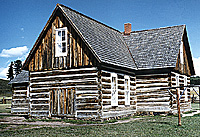 This unusually large house was built with locally cut wood in 1878 by an
exceptionally talented axe man. The trees were taken from the hills behind the
home site and were hewn when green with a broad axe and adze. Then the logs
were allowed to season for one year before building. The corner notches,
demonstrating dovetail or eastern saddle notch, were cut with such care that no
nails or pins are needed even after 110 years.
This unusually large house was built with locally cut wood in 1878 by an
exceptionally talented axe man. The trees were taken from the hills behind the
home site and were hewn when green with a broad axe and adze. Then the logs
were allowed to season for one year before building. The corner notches,
demonstrating dovetail or eastern saddle notch, were cut with such care that no
nails or pins are needed even after 110 years.
BUNKHOUSE
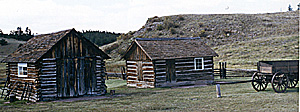 The original Hornbek bunkhouse probably served as a year-round home to
one or two ranch hands. Seasonal help was usually hired during round-up and
branding, and for harvesting potatoes and hay. Later, landowners used the
bunkhouse as a smokehouse and converted its log roof to dirt. Thus it met its end.
The original Hornbek bunkhouse probably served as a year-round home to
one or two ranch hands. Seasonal help was usually hired during round-up and
branding, and for harvesting potatoes and hay. Later, landowners used the
bunkhouse as a smokehouse and converted its log roof to dirt. Thus it met its end.
CARRIAGE SHED
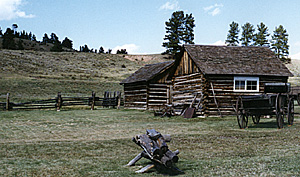 This carriage shed was built in 1928 and served as a garage for a Model T.
The log structure is thought to be similar to Adeline's shed. Her carriage shed was
used for storage of wagons and horse-drawn buggies. It may have also housed a
small blacksmith's shop which was necessary for ranch maintenance.
This carriage shed was built in 1928 and served as a garage for a Model T.
The log structure is thought to be similar to Adeline's shed. Her carriage shed was
used for storage of wagons and horse-drawn buggies. It may have also housed a
small blacksmith's shop which was necessary for ranch maintenance.
BARN
ROOT CELLAR
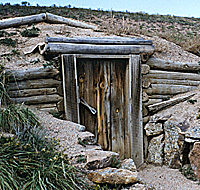 The root cellar was an early ice box. Adeline's cellar was used to store
potatoes and garden vegetables. Glass jars of preserves could be stored here in
the winter to prevent freezing. A cellar was usually one of the first things built by a
homesteader. It was built into the hillside and covered with dirt for insulation. A
double door system makes this one especially efficient. When left closed, the
temperaturestays near 45 degrees year round. In the winter, ice was cut from
neighboring ponds, hauled here by sled and stored in sawdust. The ice normally
lasted through the summer. Occasionally, the potatoes or other vegetables would
sprout roots while being stored, hence the name "root cellar".
The root cellar was an early ice box. Adeline's cellar was used to store
potatoes and garden vegetables. Glass jars of preserves could be stored here in
the winter to prevent freezing. A cellar was usually one of the first things built by a
homesteader. It was built into the hillside and covered with dirt for insulation. A
double door system makes this one especially efficient. When left closed, the
temperaturestays near 45 degrees year round. In the winter, ice was cut from
neighboring ponds, hauled here by sled and stored in sawdust. The ice normally
lasted through the summer. Occasionally, the potatoes or other vegetables would
sprout roots while being stored, hence the name "root cellar".
EPILOGUE OF ADELINE'S CHILDREN
Box 185
Florissant, Colorado 80816
719-748-3253
Admission: $2.
Back to List of Historic Sites
Back to Travel Master List
Back to MagWeb Master List of Magazines
© Copyright 1998 by Coalition Web, Inc.
This article appears in MagWeb (Magazine Web) on the Internet World Wide Web.
Other military history articles and gaming articles are available at http://www.magweb.com